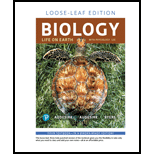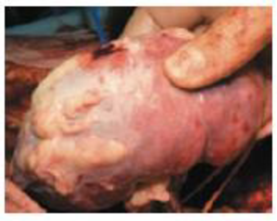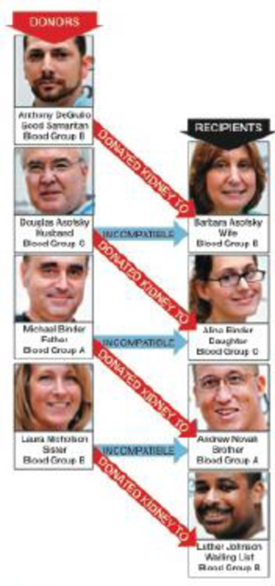
Concept explainers
Since the 1950s, when living kidney donation was first recognized as a viable alternative to cadaver organ donors, family and friends have come forward to offer a kidney to a victim of kidney failure. To reduce the chance that the recipient’s immune system will attack the donated kidney as if it were an invading microbe or
To remove a donor kidney (FIG. 36-9), surgeons generally use a technique called laparoscopic surgery, where they make half-inch incisions through which they insert surgical tools, including a tiny video camera to guide the operation. The kidney is extracted through an incision about 2½ inches long, put on ice, and rushed to its recipient. The operation takes 3 to 4 hours; donors remain in the hospital for about 3 days and return to work in about 3 weeks. In addition to the risks associated with major surgery, kidney donors will lack a backup kidney in the unlikely event that their remaining kidney fails. But a recent study of deaths among 80,000 kidney donors during a 15-year period found no greater mortality among this group (once they had recovered from their surgery) than among non-donors.

FIGURE 36-9 Surgeons transplant a kidney
Domino donations are almost always started spontaneously by someone inspired to make a difference. Since 2008, when DeGiulio’s donated kidney started a chain that saved four lives (FIG. 36-10), such domino donation chains have become longer and more frequent. For example, during a 4-month period, 17 hospitals in 11 states from California to New Jersey matched 30 people—who might otherwise have died—with kidneys from 30 donors they had never met. This heroic enterprise was started by Good Samaritan Rick Ruzzamenti, who got the idea from the desk clerk at his yoga studio, who had mentioned to him that she had donated a kidney to a friend. “People think it’s so odd that I’m donating a kidney,” he told the transplant coordinator at his hospital, but “I think it’s so odd that they think it’s so odd. . . . It causes a shift in the world.”

FIGURE 36-10 Domino donations Kidneys from compatible strangers saved the lives of these four recipients.
The more than 100,000 eligible individuals awaiting a kidney transplant ardently hope that domino donation chains continue to be forged and to lengthen.
CONSIDER THIS Would you donate a kidney to a friend or family member whose kidneys were failing? Would you consider donating a kidney to a stranger? Explain your reasoning.
Want to see the full answer?
Check out a sample textbook solution
Chapter 36 Solutions
Pearson eText Biology: Life on Earth with Physiology -- Instant Access (Pearson+)
- What is this?arrow_forwardMolecular Biology A-C components of the question are corresponding to attached image labeled 1. D component of the question is corresponding to attached image labeled 2. For a eukaryotic mRNA, the sequences is as follows where AUGrepresents the start codon, the yellow is the Kozak sequence and (XXX) just represents any codonfor an amino acid (no stop codons here). G-cap and polyA tail are not shown A. How long is the peptide produced?B. What is the function (a sentence) of the UAA highlighted in blue?C. If the sequence highlighted in blue were changed from UAA to UAG, how would that affecttranslation? D. (1) The sequence highlighted in yellow above is moved to a new position indicated below. Howwould that affect translation? (2) How long would be the protein produced from this new mRNA? Thank youarrow_forwardMolecular Biology Question Explain why the cell doesn’t need 61 tRNAs (one for each codon). Please help. Thank youarrow_forward
- Molecular Biology You discover a disease causing mutation (indicated by the arrow) that alters splicing of its mRNA. This mutation (a base substitution in the splicing sequence) eliminates a 3’ splice site resulting in the inclusion of the second intron (I2) in the final mRNA. We are going to pretend that this intron is short having only 15 nucleotides (most introns are much longer so this is just to make things simple) with the following sequence shown below in bold. The ( ) indicate the reading frames in the exons; the included intron 2 sequences are in bold. A. Would you expected this change to be harmful? ExplainB. If you were to do gene therapy to fix this problem, briefly explain what type of gene therapy youwould use to correct this. Please help. Thank youarrow_forwardMolecular Biology Question Please help. Thank you Explain what is meant by the term “defective virus.” Explain how a defective virus is able to replicate.arrow_forwardMolecular Biology Explain why changing the codon GGG to GGA should not be harmful. Please help . Thank youarrow_forward
- Stage Percent Time in Hours Interphase .60 14.4 Prophase .20 4.8 Metaphase .10 2.4 Anaphase .06 1.44 Telophase .03 .72 Cytukinesis .01 .24 Can you summarize the results in the chart and explain which phases are faster and why the slower ones are slow?arrow_forwardCan you circle a cell in the different stages of mitosis? 1.prophase 2.metaphase 3.anaphase 4.telophase 5.cytokinesisarrow_forwardWhich microbe does not live part of its lifecycle outside humans? A. Toxoplasma gondii B. Cytomegalovirus C. Francisella tularensis D. Plasmodium falciparum explain your answer thoroughly.arrow_forward
- Select all of the following that the ablation (knockout) or ectopoic expression (gain of function) of Hox can contribute to. Another set of wings in the fruit fly, duplication of fingernails, ectopic ears in mice, excess feathers in duck/quail chimeras, and homeosis of segment 2 to jaw in Hox2a mutantsarrow_forwardSelect all of the following that changes in the MC1R gene can lead to: Changes in spots/stripes in lizards, changes in coat coloration in mice, ectopic ear formation in Siberian hamsters, and red hair in humansarrow_forwardPleiotropic genes are genes that (blank) Cause a swapping of organs/structures, are the result of duplicated sets of chromosomes, never produce protein products, and have more than one purpose/functionarrow_forward
 Human Biology (MindTap Course List)BiologyISBN:9781305112100Author:Cecie Starr, Beverly McMillanPublisher:Cengage Learning
Human Biology (MindTap Course List)BiologyISBN:9781305112100Author:Cecie Starr, Beverly McMillanPublisher:Cengage Learning Human Physiology: From Cells to Systems (MindTap ...BiologyISBN:9781285866932Author:Lauralee SherwoodPublisher:Cengage Learning
Human Physiology: From Cells to Systems (MindTap ...BiologyISBN:9781285866932Author:Lauralee SherwoodPublisher:Cengage Learning Comprehensive Medical Assisting: Administrative a...NursingISBN:9781305964792Author:Wilburta Q. Lindh, Carol D. Tamparo, Barbara M. Dahl, Julie Morris, Cindy CorreaPublisher:Cengage Learning
Comprehensive Medical Assisting: Administrative a...NursingISBN:9781305964792Author:Wilburta Q. Lindh, Carol D. Tamparo, Barbara M. Dahl, Julie Morris, Cindy CorreaPublisher:Cengage Learning Human Heredity: Principles and Issues (MindTap Co...BiologyISBN:9781305251052Author:Michael CummingsPublisher:Cengage Learning
Human Heredity: Principles and Issues (MindTap Co...BiologyISBN:9781305251052Author:Michael CummingsPublisher:Cengage Learning





